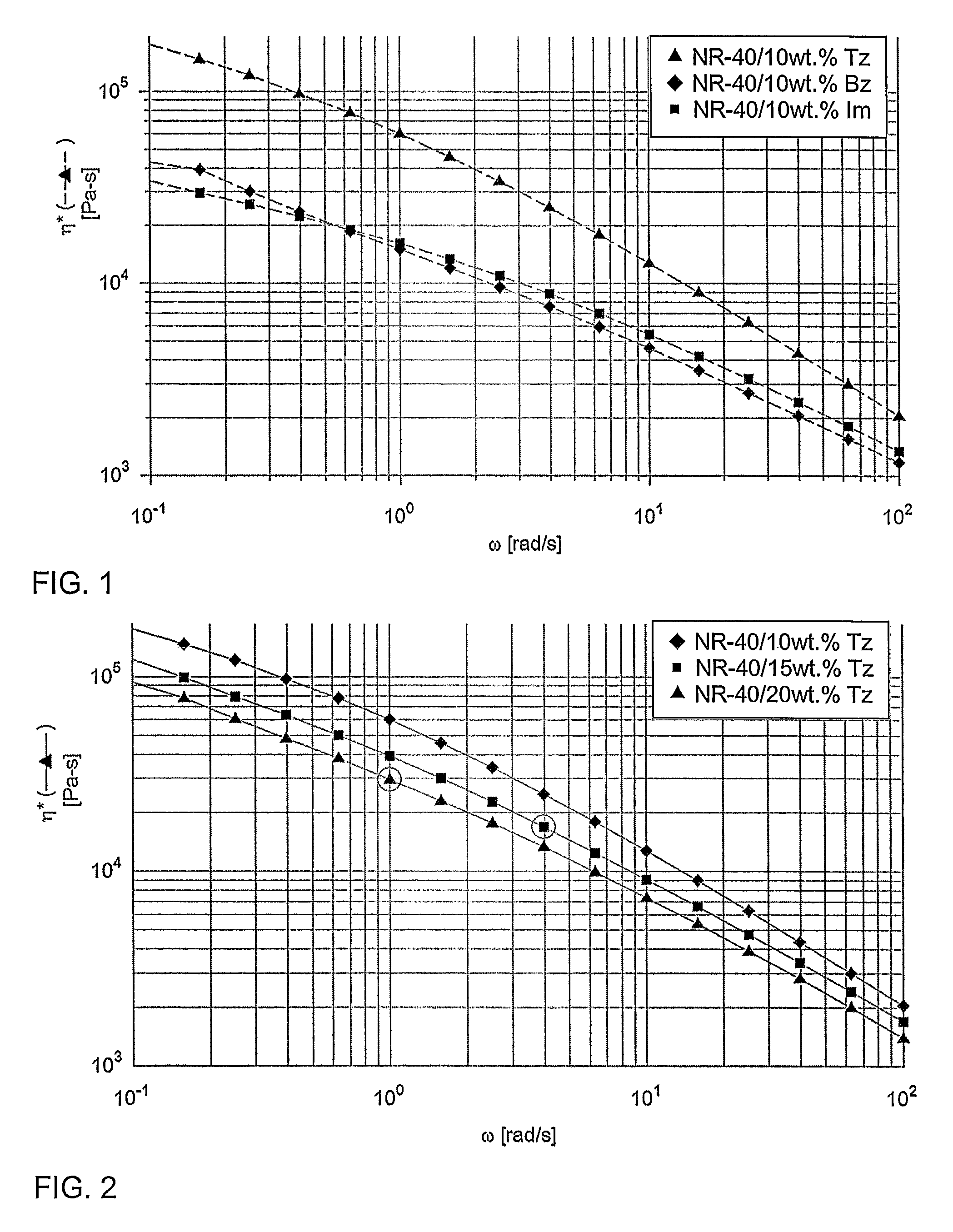Process for producing ion exchange membranes by melt-processing of acidic PFSA ionomers
a technology of acidic ionomers and ionomer, which is applied in the direction of sustainable manufacturing/processing, final product manufacturing, electrochemical generators, etc., can solve the problems of gas crossover and ultimately failure of fuel cells, add complexity to an otherwise simple process, and achieve melt-processing. the effect of success
- Summary
- Abstract
- Description
- Claims
- Application Information
AI Technical Summary
Benefits of technology
Problems solved by technology
Method used
Image
Examples
example 1
Preparation of PFSA / Additive Blends and their Rheological Characterization
[0043]Two additives useful in the present invention (1,2,4-triazole (Tz) and benzimidazole (Bz)) and one comparative additive from the prior art (imidazole (Im)) were selected. Nafion™ / additive (10 wt %) blends were prepared by dissolving the additive in water followed by addition of the solution to Nafion™ NR40 and stirring to allow a homogeneous swelling of the ionomer. The blends were then dried at 60° C. overnight under vacuum to remove the water. The dried solid mixture was then analyzed in a rheometer. FIG. 1 shows the results of the frequency sweep test at 260° C., where the dynamic complex viscosity (Eta* or η*) is represented as a function of the oscillation frequency. While the Nafion™ NR40 sample was impossible to analyze due to its very high viscosity and visible thermal degradation of the acidic groups, the Nafion™ / additive samples show a flow behavior as the additive forms a conjugated acid with ...
example 2
Effect of the Concentration of Additive on the Melt-Viscosity
[0044]Nafion™NR40 / 1,2,4-triazole blends were prepared as described in Example 1, with additive loadings of 10, 15 and 20 wt % corresponding to 1.6, 2.6 and 3.6 mol of 1,2,4-triazole per mol of SO3− respectively. FIG. 2 shows the results of the frequency sweep test at 240° C., where the dynamic complex viscosity is represented as a function of the oscillation frequency. Nafion™NR40 / 1,2,4-triazole blends show a decrease in the viscosity as the concentration of additive increases.
example 3
Melt-Processability of the Acid Ionomer / Additive Blends Prepared in Examples 1 And 2 to Produce Practical Thin Membranes
[0045]A blend based on Aquivion® short side chain PFSA ionomer (EW=830 g / eq) and 15 wt % 1,2,4-triazole was also prepared as described in Example 1. Melt-processing was carried out at 260° C., using a 5 cc bench-top micro-extruder (DSM-Explore) equipped with a film line. The die used for thin film preparation has an opening gap of 0.1 mm and a width of 3.5 cm. The screws RPM, the calender rolls speed and torque was varied to achieve the required thickness. The strips of membranes obtained had a final width of approximately 2.5 cm and a thickness in the range of 5 to 50 microns.
[0046]Melt-processing to produce PFSA-based thin and transparent membranes was successful with triazole and benzimidazole additives. However, it is particularly noteworthy that melt-processing using imidazole as the additive completely failed to produce PFSA-based membranes, despite the fact ...
PUM
| Property | Measurement | Unit |
|---|---|---|
| thickness | aaaaa | aaaaa |
| thickness | aaaaa | aaaaa |
| boiling point | aaaaa | aaaaa |
Abstract
Description
Claims
Application Information
 Login to View More
Login to View More - R&D
- Intellectual Property
- Life Sciences
- Materials
- Tech Scout
- Unparalleled Data Quality
- Higher Quality Content
- 60% Fewer Hallucinations
Browse by: Latest US Patents, China's latest patents, Technical Efficacy Thesaurus, Application Domain, Technology Topic, Popular Technical Reports.
© 2025 PatSnap. All rights reserved.Legal|Privacy policy|Modern Slavery Act Transparency Statement|Sitemap|About US| Contact US: help@patsnap.com



